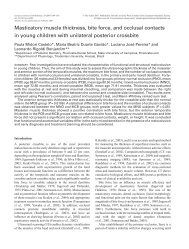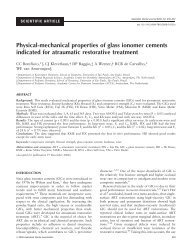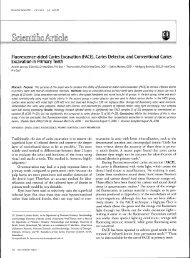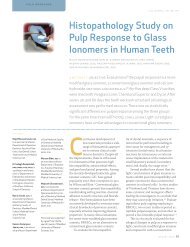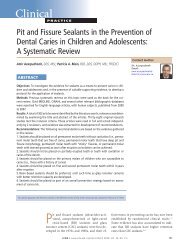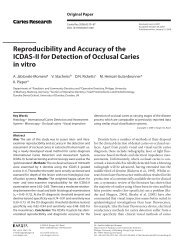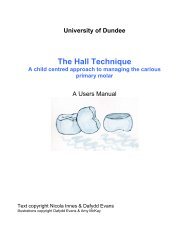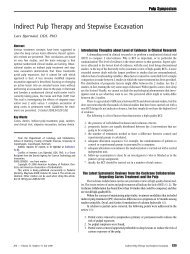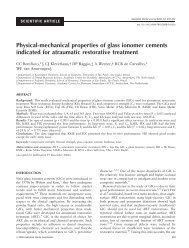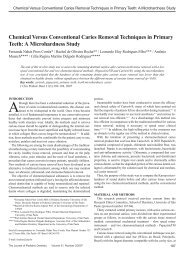Quintessence Journals - Sandra Kalil Bussadori
Quintessence Journals - Sandra Kalil Bussadori
Quintessence Journals - Sandra Kalil Bussadori
Create successful ePaper yourself
Turn your PDF publications into a flip-book with our unique Google optimized e-Paper software.
Copyright<br />
Table 2 Number of teeth according to allocation to the different cavity depth groups, the use of<br />
calcium hydroxide liner, and the kind of restorative material<br />
Calcium hydroxide liner Restorative material Cavity depth group<br />
shallow medium deep<br />
Not for Publication<br />
Wegehaupt et al<br />
<strong>Quintessence</strong><br />
for<br />
Not<br />
by<br />
Yes buildup 6 8 9<br />
definitive filling 14 21 17<br />
No buildup 5 5 7<br />
definitive filling 16 5 10<br />
Table 3 Percentages (absolute number) of pain incidence or hypersensitivity of the buildup and definitive<br />
restorations placed in either shallow, medium or deep cavities after use of a calcium hydroxide lining<br />
or not<br />
Calcium hydroxide liner Restorative material Cavity depth group<br />
shallow medium deep<br />
yes buildup 17% (1) 0% (0) 11% (1)<br />
definitive filling 14% (2) 14% (3) 11% (2)<br />
no buildup 40% (2) 0% (0) 29% (2)<br />
definitive filling 13% (2) 40% (2) 40% (4)<br />
On the basis of the RDTMD results, the cavities were divided<br />
into three different groups (shallow, medium, or<br />
deep cavity) of 40 teeth each. Cavities with RDTMD scores<br />
1 to 5 (1.5 to 3.0 mm, green or yellow LEDs) were allocated<br />
to group “shallow”, cavity scores 6 and 7 (0.9 to 1.5<br />
mm, orange LEDs) were allocated to group “medium”, and<br />
with results 8 to 10 (< 0.9 mm, red LEDs) to group “deep”.<br />
In each group, cavities were treated either with or without<br />
use of calcium hydroxide liner (Kerr Life, KerrHawe; Bioggio,<br />
Switzerland). The decision to use a calcium hydroxide<br />
liner or not was made by tossing a coin. This resulted in<br />
20 liners being placed in the shallow group, 29 in the<br />
medium-depth group, and 26 in the group of deep cavities<br />
(Table 2).<br />
To make the calcium hydroxide liner, a small drop of<br />
Kerr Life was placed on the deepest part of the cavity and<br />
allowed to set until its surface was hard upon probing.<br />
The restoration of the teeth was performed either with a<br />
buildup composite (n = 40) (LuxaCore, DMG; Hamburg,<br />
Germany) or a hybrid composite (n = 83) (Spectrum,<br />
Dentsply DeTrey; Konstanz, Germany). For the buildup<br />
composite restorations, a self-etching nonrinse adhesive<br />
system was used (Clearfil Liner Bond 2V, Kuraray Dental).<br />
The buildup composite was used when a large amount of<br />
dental hard tissue was lost and an indirect restoration was<br />
required (crown or partial crown) later to stabilize the integrity<br />
of the tooth or when the cervical margin was located<br />
subgingivally. An etch-and-rinse adhesive<br />
(Prime&Bond NT, Dentsply) was used in the remaining cavities<br />
that were restored with the hybrid composite Spectrum.<br />
These were Class I and II restorations (O, OM/OD,<br />
and MOD) with the cervical margin located para- or<br />
supragingivally. During the restoration, steel matrices were<br />
used and fixed with wooden wedges. The hybrid composite<br />
for the definitive restorations was applied in the cavities in<br />
small horizontal increments with a maximum height of 1<br />
mm. Application protocols for the two kinds of adhesives<br />
and restorative materials are given in Table 1.<br />
The patients were not told to which cavity-depth group<br />
their tooth was allocated and if calcium hydroxide was<br />
used or not. The patients were asked to record whether<br />
any hypersensitivity, pain, or discomfort occurred following<br />
treatment.<br />
During a second appointment 6 months later, the patients<br />
were re-examined by one dentist evaluating the following<br />
criteria:<br />
• Vitality test (yes/no): vitality testing was performed with<br />
a cold foam pellet pressed on the buccal surface of the<br />
tooth. The patients were asked to report whether they<br />
felt the cold.<br />
• Occurrence of hypersensitivity (yes/no): the patients<br />
were asked if they had noticed any pain, hypersensitivity,<br />
or discomfort in the teeth after the application of<br />
the filling.<br />
Reacting negative to the vitality test and reported pain<br />
or hypersensitivity were ranked as failure.<br />
To evaluate the influence of the three different variables<br />
“cavity depth”, “calcium hydroxide liner”, and “resto-<br />
Vol 11, No 2, 2009 139





